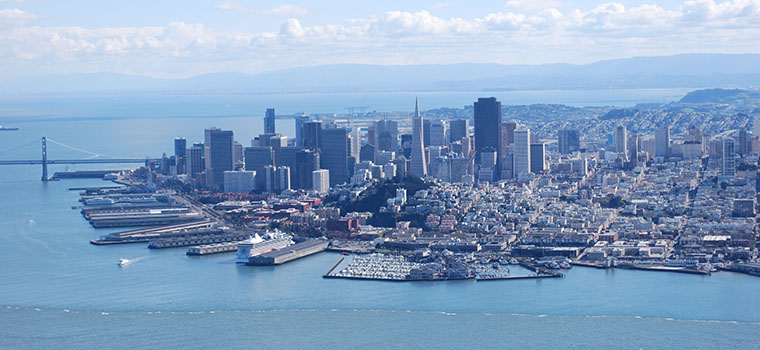Nearly three-quarters of voters say they would vote "yes" on a bond measure to fund improvements to San Francisco's seawall, based on a citywide voter survey conducted in January on behalf of the Port of San Francisco.

San Francisco’s vulnerable seawall stretches from Fisherman’s Wharf to Mission Creek near AT&T Park. A large investment is needed to protect it from a major seismic event. Photo by Joel Williams
BC STAFF REPORT
Published: March, 2018
Nearly three-quarters of voters say they would vote “yes” on a bond measure to fund improvements to San Francisco’s seawall, based on a citywide voter survey conducted in January on behalf of the Port of San Francisco. Seventy-three percent of voters polled were in favor of a proposed general obligation bond measure of up to $500 million being considered for the November 2018 ballot, which would help protect and strengthen the Embarcadero Seawall. The bond measure would require two-thirds voter approval and will not raise tax rates.
The City of San Francisco, through the San Francisco Port Commission, is endeavoring to make major improvements to the century-old Embarcadero Seawall so the city can withstand the next major earthquake and can prepare for sea level rise. The seawall underpins the Embarcadero Roadway and provides flood protection to over 500 acres of the city, including the Muni Metro Embarcadero tunnel.
The seawall, which stretches three miles from Fisherman’s Wharf to Mission Creek, sits over unstable mud and is vulnerable to lateral spreading and settlement in a major earthquake, which could destroy or seriously damage utilities, light rail and buildings along the Embarcadero.
Major investment in the seawall is required for the Embarcadero to function properly after a major seismic event: as a place for people to exit downtown and to access ferries, for first responders to access downtown, for the delivery of supplies and to remove debris. The seawall is also subject to current flooding, with lane closures during King Tides, and there is a current flood risk to the Muni tunnel along the Embarcadero.
Port of San Francisco staff have started a citywide public education effort about these issues, and in February, port staff presented the details of their citywide efforts to the San Francisco Port Commission along with the results of the voter survey. While more than half of voters surveyed reported visiting the San Francisco waterfront multiple times a month (54 percent), only one in three (35 percent) said they were familiar with the city’s seawall.
“The Embarcadero Roadway, the Downtown Ferry Terminal and the City Auxiliary Water Supply System are key parts of San Francisco’s emergency response network,” said San Francisco Mayor Mark Farrell. “Ensuring the seismic safety of the seawall supports disaster response across all corners of the city—and voters understand this.”
The Seawall Earthquake Safety Program is led by the Port of San Francisco, in consultation with the San Francisco Municipal Transportation Agency, the San Francisco Public Utilities Commission, San Francisco Public Works, the San Francisco Planning Department and City Administrator Naomi Kelly.
“The seawall supports critical regional transportation, utilities and emergency response infrastructure, and we are glad to know that San Francisco voters understand the urgency of protecting our city by strengthening the seawall,” said City Administrator Kelly.
After learning more about the Embarcadero Seawall and its role in protecting the city, voter support rose to 78 percent in favor of strengthening and protecting this vital piece of infrastructure. “The Embarcadero Seawall is vital to our transportation networks—nearly a million people arrive daily via ferries and BART and Muni—and that means we need to act quickly,” said Kimberly Brandon, president of the San Francisco Port Commission.
“The poll results are very encouraging and confirm that the port priority to strengthen the seawall is the right priority,” said Elaine Forbes, executive director of the Port of San Francisco. “We need to strongly engage the public on this effort because the seawall is unseen infrastructure and communities citywide have a stake in a safer waterfront.”
Strong support by San Francisco voters for the proposed bond measure was seen in all supervisorial districts and across demographics including income, age and supervisorial district. Protecting vulnerable parts of San Francisco’s citywide water, sewer and electrical infrastructure was extremely or very important to 88 percent of those polled, and ensuring that firefighters can access water supply to fight fires after an earthquake was extremely or very important to 86 percent of those polled.
Climate change and the likelihood of a strong earthquake in the future are also concerns that voters cited as reason to invest in the Embarcadero Seawall.

